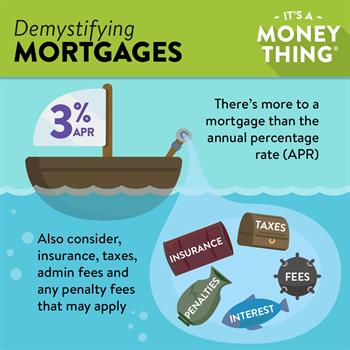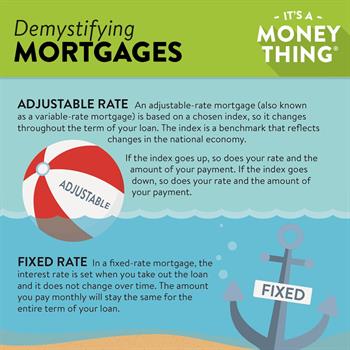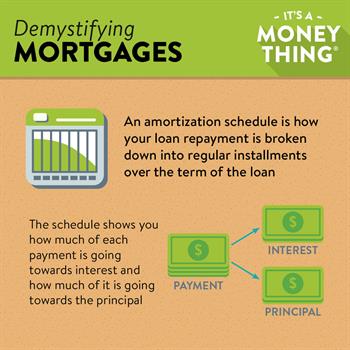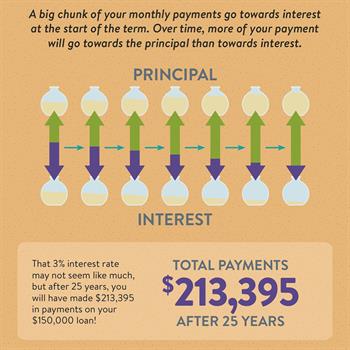It's a Money Thing®
Demystifying Mortgages
The American dream of owning a home continues to be alive and well. According to a recent Gallup poll, eight out of 10 adults either own a home or plan to buy one in the future. Whether you are purchasing a home for the investment to build equity and credit or as a point of pride and a place to raise a family, buying a home is likely the biggest purchase of your life and you'll need a loan to make it happen. Comparing mortgages can be confusing and intimidating- let's break it all down so you can understand how it works.
Asking the right questions is an important part of every financial decision you make, and home ownership is no exception. If you’ve been thinking about buying a place, preliminary research will turn up a long checklist of questions for you to ask at every part of the process.
One of the first questions you may ask will be about the interest rate on your mortgage loan. When shopping for a mortgage, financial institutions have products with an advertised APR, which stands for Annual Percentage Rate. However, the APR doesn't tell the whole story. You also need to understand that there are a wide range of additional costs to consider when purchasing a home, including insurance, taxes, administrative fees and any penalty fees that may apply.
The APR may also have different implications or even change based on the type of mortgage being promoted. Let 's look at that next.


Mortgages come in two main types: Adjustable-Rate, sometimes referred to as ARMs or Variable-Rate, and Fixed-Rate. Deciding which type of mortgage is best can be a trade off.
Fixed-rate mortgages are consistent and easier to budget for, but tend to have higher interest to counter the effect of rates rising in the future.
Adjustable-rate mortgages usually have a lower advertised start rate, which is very appealing, but can be unpredictable and harder to budget for. Many people who choose an adjustable-rate mortgage only plan to live in their home for a short time, between five and seven years.
In the end, it's your decision which product is best for you. Think about your income, your future, how long you plan to live in the home and your risk tolerance before making your decision.
Your lender will provide you with an amortization schedule once you have closed on your loan which shows how your repayment is broken down into regular installments over the entire term of the loan.
The schedule also shows you how much of each payment is going towards interest and how much is going towards the principal (or the balance of the loan).
Let's say you have a $150,000 fixed-rate mortgage with a 3% annual interest rate amortized over a 25-year period. Your payment will be $711 per month. The monthly payment for a fixed-rate mortgage is the amount paid by the borrower every month that ensures that the loan is paid off in full with interest at the end of the term.
Let's calculate how your first payment breaks down between interest and principal: $150,000 x 3% = $4,500/12 months = $375
That is the portion of your payment that will go towards interest, while the remaining $336 will go towards your outstanding balance.


Your monthly payment is recalculated each month based on the remaining balance of your loan. Therefore, the amount of your payment that goes towards interest vs. principal will change each month. You should see that the interest portion of your monthly payment will be slightly lower and the principal portion will be slightly higher as you continue to make payments.
You will find that the interest adds up over the life of your loan. Remember your $150,000 fixed-rate loan at 3%? Once you have paid it off, you will have paid $213,395 in interest after 25 years. That number sure hits home!
A mortgage can be an empowering experience or a burden. It all comes down to your understanding of the mortgage products available, honesty regarding your personal finances, and clarity about your life situation.
